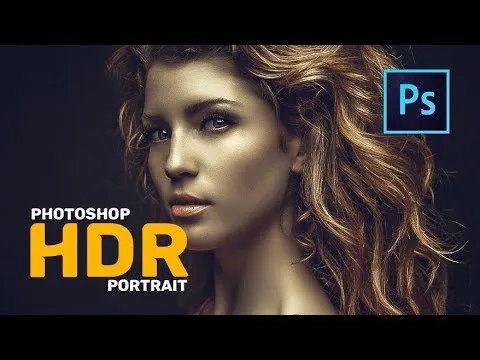
How to Apply HDR Effects to Portraits Using Photoshop
High Dynamic Range (HDR) techniques have gained popularity in photography for their ability to capture a wide range of tones and details in a single image. While commonly associated with landscape and architectural photography, HDR effects can also be effectively applied to portraits, adding depth and vibrancy to the subjects. This blog guide explores how to apply HDR effects to portraits using Adobe Photoshop. By merging multiple bracketed exposures and utilizing Photoshop’s powerful tools, we can enhance the dynamic range of portraits, creating stunning and visually appealing results.
Step-by-Step Guide for Applying HDR Effects to Portraits in Photoshop:
Step 1: Preparing Your Images
The first crucial step of applying HDR effects to portraits in Photoshop is to prepare your images properly. That involves capturing bracketed exposures and organizing them effectively.
Capturing Bracketed Exposures: To create an HDR image, you need a series of bracketed exposures that cover a wide range of tones. Bracketing involves capturing multiple images of the same scene at different exposure settings. It is suggested to use a tripod to maintain consistency across the shots. Start by setting your camera to auto-bracketing mode or manually adjusting the exposure settings for each image, ensuring a range from underexposed to overexposed.
Importing and Organizing Images: Once you have captured the bracketed exposures, importing and organizing them for easy access during the HDR merging process is important. Create a dedicated folder on your computer and transfer the images into it. Organize them logically, either by capturing time or exposure values. By organizing your images, you’ll save time and effort when working with them in Photoshop.
It’s worth noting that you can also work with a single RAW file instead of multiple bracketed exposures. In such cases, ensure the RAW file contains sufficient dynamic range information for the HDR effect you intend to achieve.
By taking the time to capture bracketed exposures and organizing them efficiently, you set the foundation for a successful HDR editing process. These preparatory steps ensure that you have the necessary image data and an organized workflow, allowing you to move seamlessly into the next stage of merging and processing the exposures in Photoshop.
Step 2: Merging Exposures and Creating HDR Image
Once you have prepared your bracketed exposures or RAW file, it’s time to merge them and create the HDR image in Adobe Photoshop. This step will enable you to combine the different exposures and unlock the full dynamic range of your portrait.
Opening Images in Photoshop: Begin by launching Adobe Photoshop and selecting “File” > “Scripts” > “Load Files into Stack.” This option allows you to import all the bracketed exposures or the single RAW file you wish to merge. Click the “Browse” option and navigate to your images’ folder. Select the images you wish to merge, then click “OK” to import them into Photoshop.
HDR Merging: Once the images are loaded into Photoshop, go to “Layer” > “Smart Objects” > “Convert to Smart Object.” This step helps maintain flexibility and non-destructive editing throughout the HDR process. With the Smart Object layer selected, navigate to “Enhance” > “HDR Toning” to access the HDR merging options.
You can adjust various settings to fine-tune the merging process in the HDR Toning dialogue box. These include exposure, gamma, edge glow, and more. Experiment with these settings to achieve the desired HDR effect while maintaining a natural appearance for your portrait.
After making adjustments, click “OK” to create the HDR image. Photoshop will blend the different exposures or process the RAW file to produce a high dynamic range image that captures a wide range of details and tones.
Step 3: Tone Mapping and Adjustments
Now that you have created the HDR image, it’s time to apply tone mapping and make adjustments to refine your portrait’s overall look and feel.
Tone Mapping: Tone mapping is a crucial step in HDR editing that allows you to control the dynamic range and bring out the desired details and contrast in your image. You can use various tone mapping methods in Adobe Photoshop, such as Local Adaptation, Tone Compression, or the HDR Toning panel.
Adjusting Tone and Contrast: With the HDR image selected, navigate to the “Image” menu and choose options like “Levels,” “Curves,” or “Brightness/Contrast” to make precise adjustments to the overall tone and contrast. These tools enhance the highlights and shadows, ensuring a balanced and visually appealing portrait.
Fine-tuning Colors and Saturation: To further enhance the visual impact of your HDR portrait, you can fine-tune the colours and saturation. Utilize tools like “Vibrance,” “Hue/Saturation,” or selective adjustments to boost or tone down specific colour ranges. This step lets you achieve your portrait’s desired colour balance and vibrancy while maintaining a natural appearance.
By carefully applying tone mapping techniques and adjusting the tone, contrast, and colours, you can elevate your HDR portrait to new levels of visual appeal.
Step 4: Refining Details and Noise Reduction
Refining the details and addressing noise issues are important aspects of enhancing the quality of your HDR portrait. This step will explore techniques to sharpen the details and reduce noise, ensuring a polished and professional look.
Sharpening and Detail Enhancement: To enhance your portrait’s fine details, use Photoshop’s sharpening tools. Options like “Unsharp Mask,” “High Pass filter,” or “Smart Sharpen” can help sharpen specific areas or the overall image. Apply these tools judiciously to avoid over-sharpening, which can lead to unnatural artefacts.
Noise Reduction: HDR processing can sometimes introduce noise, especially in the shadow areas. To reduce noise, access Photoshop’s noise reduction tools, such as the “Noise Reduction” filter or “Camera Raw.” Experiment with the settings to find the right balance between noise reduction and preserving the essential details of your portrait.
Finding the optimal balance between sharpening and noise reduction is essential to achieve a clean and detailed HDR portrait. Take the time to refine these aspects, ensuring a visually pleasing and professional result.
Step 5: Final Touches and Exporting
In the final step of applying HDR effects to your portrait in Photoshop, it’s time to add those finishing touches and prepare your image for presentation or printing.
Applying Creative Filters or Effects: To add a personal touch and enhance the artistic appeal of your HDR portrait, consider applying creative filters or effects. Experiment with vignettes, colour grading, or selective adjustments to create a unique and visually captivating final result.
Saving and Exporting: Once you are satisfied with the final look of your HDR portrait, it’s time to save and export it. Choose the appropriate file format, such as JPEG or TIFF, and specify the desired quality settings. Consider the intended use of the image and any specific requirements for printing or online display.
With the final touches applied and the image saved, you can now showcase your stunning HDR portrait to the world through online platforms or printed displays.
Some Important Considerations:
When applying HDR effects to portraits in Photoshop, keep the following considerations in mind:
Maintain a Natural Look:
While HDR can create dramatic and striking effects, it’s essential to strike a balance and maintain a natural appearance in your portraits. Avoid over-processing or exaggerating the HDR effect, resulting in an artificial or unnatural look. Pay attention to skin tones, shadows, and highlights, ensuring they look realistic and pleasing to the eye.
Preserve Facial Details:
Portraits often rely on capturing the fine details of a subject’s face. When applying HDR, be mindful of not losing or obscuring those essential details. Adjust the tone mapping and sharpening techniques carefully to enhance the details without introducing artefacts or making the image appear too sharp.
Consider the Portrait’s Mood and Style:
HDR effects can vary depending on your portrait’s intended mood and style. Consider the subject’s expression, the lighting conditions, and the desired atmosphere. Adjust the tone mapping and colour adjustments to reflect the intended mood, whether it’s a vibrant and energetic look or a softer, more subdued atmosphere.
Evaluate Noise and Artifacts:
HDR processing can sometimes introduce noise or artefacts, particularly in the shadow areas. Keep an eye out for any unwanted noise and use noise reduction tools to minimize its impact while maintaining image quality. Regularly zoom in and inspect your portrait to ensure there are no visible artefacts or distortion caused by HDR processing.
Experiment and Practice:
HDR editing is a creative process that requires experimentation and practice to achieve the desired results. Don’t be afraid to try different settings, techniques, and adjustments to find your unique style and approach to HDR portraits. Regularly evaluate your work, seek feedback, and learn from the results to continuously improve your skills.
Considering these important factors will create visually stunning HDR portraits that enhance the overall impact and bring out the beauty of your subjects while maintaining a natural and pleasing aesthetic.
Conclusion:
In conclusion, applying HDR effects to portraits using Adobe Photoshop opens up a world of creative possibilities. By systematically preparing the images, merging exposures, applying tone mapping and adjustments, refining details, and adding final touches, you can elevate your portraits to new heights of visual impact. It is crucial to balance enhancing the dynamic range and maintaining a natural appearance. Additionally, considerations such as skin texture retention, subtlety, and monitor calibration contribute to achieving stunning results. With practice and experimentation, you can master the art of applying HDR effects to portraits, unlocking the full potential of your images and captivating viewers with your artistic vision.





